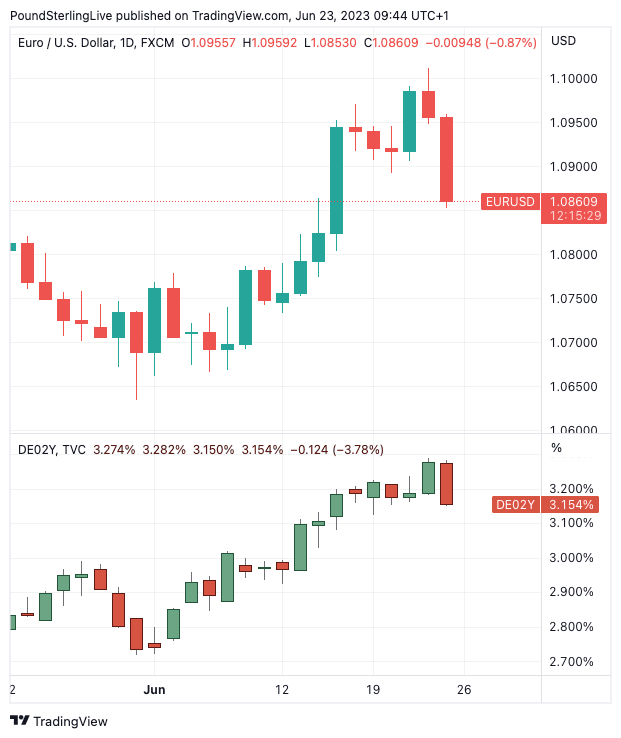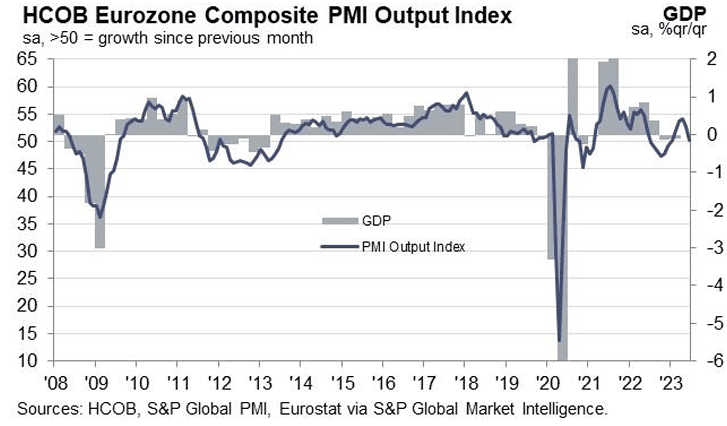Euro Slumps on "Dreadful" Eurozone PMI Release
- Written by: Gary Howes
-

Image © Adobe Images
The Euro to Dollar exchange rate (EURUSD) was under notable pressure ahead of the weekend following the release of economic survey data that one economist described as "dreadful" and prompted economists to say now could be the time for the European Central Bank (ECB) to end its rate hiking cycle.
S&P Global reported its monthly PMI survey revealed the Eurozone's economy flirted with contraction in June as the region's economic upturn fades amidst a fall in new business orders for the first time since January.
The Services PMI read at 52.4 in June, which was lower than the market's expected 54.5, making for a significant downside miss, and signalling a sharp slowdown from May's impressive 55.1.
"Euro extends drop to 1.4% from high of 1.1012 yesterday after dreadful PMIs," says Kenneth Broux, strategist at Société Générale.
The Manufacturing PMI read at 43.6, putting the sector deeper in contractionary territory. The market was looking for 44.8, which would have put it in line with May's reading.
The data gave a Composite PMI - which gives a better assessment of the broader economy - of 50.3 which puts it on the cusp of contraction. The market expected 52.5, which would have been marginally lower than May's 52.8.
France appears to have struggled in June with manufacturing and services falling into contraction (45.5 and 48 respectively). Germany's sizeable manufacturing sector also disappointed with a reading of 41, putting what was once Europe's growth engine deeper in the contraction zone.
The Euro-Dollar rate's daily decline extends to 0.80% at the time of writing, taking the pairing to 1.0866 and effectively nixing the recent uptrend.
The Eurozone's PMI survey revealed new business trends measured across goods and services worsened further in June, as new orders dropped for the first time since January, the deteriorating demand environment signals downside risks to output in July said S&P Global.
Above: The fall in Eurozone PMIs hints at a fall in GDP. Image: S&P Global.
The report finds manufacturing remains a principal area of weakness for the Eurozone, with factory output falling for a third straight month and at the fastest rate since last October.
But growth in service sector output - which has up until now kept the economy afloat - meanwhile slowed sharply as the recent resurgence in spending on services lost momentum.
"This suggests that the reopening boost to services activity is on its last legs at the moment, adding to the sluggish economic environment we’re currently in," says Bert Colijn,
Senior Economist for the Eurozone at ING Bank.
The fall in the Euro mirrors falls in Eurozone sovereign bond yields which suggests market expectations for European Central Bank (ECB) rate hikes are retreating.

Above: EURUSD (top) and German two-year bond yields.
Slowing inflation when combined with a slowing economy would give the ECB reason to consider how much further rates will need to rise.
To be sure, at least one more rate hike is coming, based on the guidance from ECB Governing Council members, but beyond this one hike question marks emerge.
But Colijn says none of this will provide a catalyst for the bank to change direction on rate hikes.
"Policymakers seem to prefer too much, rather than too little tightening right now, which sets the stage for another potential hike in September," he says.
The slowing growth impulse conveyed in the Eurozone PMIs will nevertheless raise doubts amongst market participants, which can weigh on the Euro near-term.
Holger Schmieding, Chief Economist at Berenberg Bank says the Eurozone PMI data sends a "stern warning for the ECB: Having first kept its policy too loose for too long, the European Central Bank is now at risk of making the reverse mistake."
The ECB this month raised its projections for Eurozone growth to 0.8% for 2023 and 1.5% for 2024, but Schmieding says "underlying growth in the region is screeching almost to a halt".
"As much of the impact of ECB rate hikes is still in the pipeline, it would be better for the ECB to pause soon and reassess the outlook for growth and inflation," he adds.
If the market gets a sense that this is indeed the likely trajectory for the Eurozone, the Euro could come under pressure.












